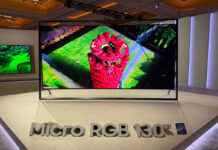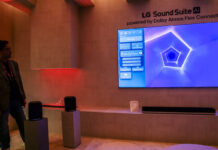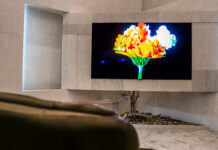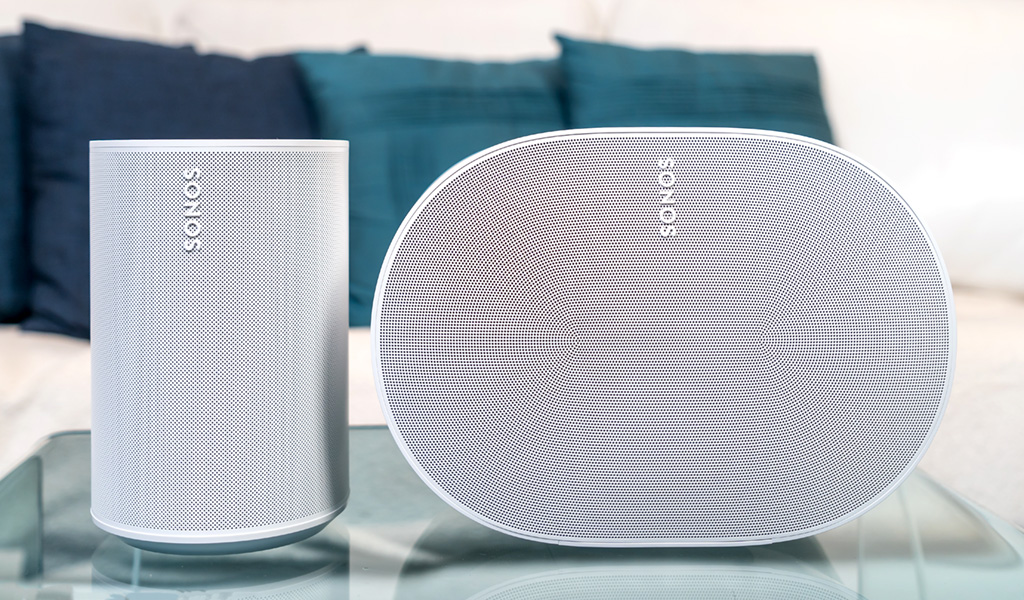
It’s too soon to tell if the Sonos Era 300 and Era 100 usher in a new “era” for the company and its speaker lineup, but listen to them and you feel like something’s new. It’s not so much the design, which takes a different approach, but rather the purpose and performance. Sonos says it built these speakers to reinvigorate a love for kicking back to enjoy some tunes.
Part of that means embracing spatial audio, but I would also argue the speakers make a case for diving into hi-res audio too. They aren’t the same, though they serve a similar purpose in making music feel immersive and special. It shouldn’t take long to listen to either one to realize Sonos put a lot of the right pieces in place to make that possible.
Design and placement
I already covered the design points when I first saw the speakers at a press event in New York in February, but much of what I saw rang true once I set them up at home. Of the two, I’d say you have to put more thought into where the Era 300 will go. For starters, spatial audio works best when the speaker isn’t constrained. Don’t put it on a bookshelf, squeeze it into a corner or nestle it somewhere it can’t really “breathe”. The best thing to do is place it with openness in mind, where its sound can truly expand and make you feel like it envelops your space.
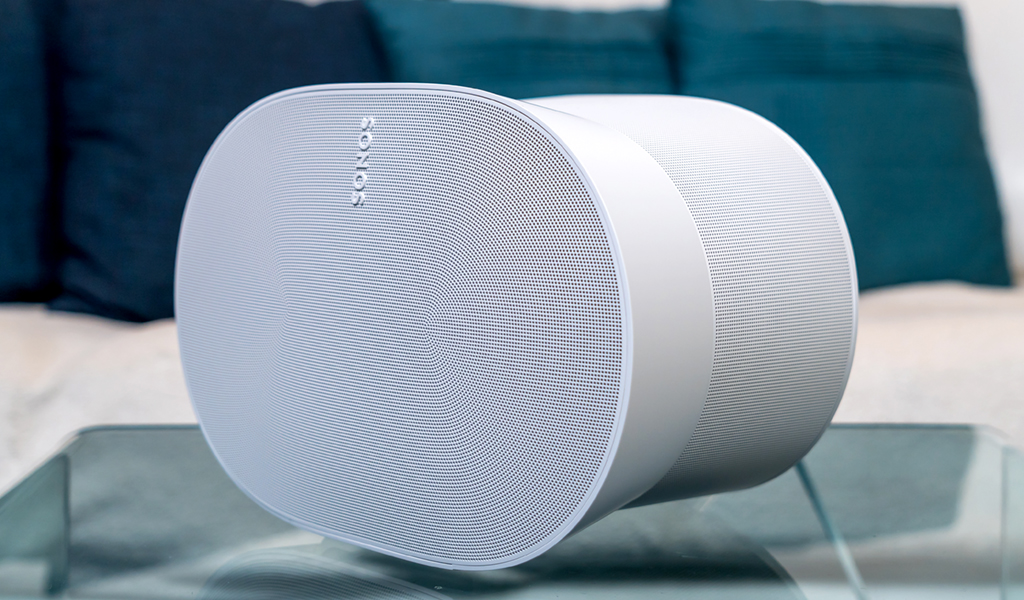
Spatial audio has a way of garnering that feeling because sound is directional. The Era 300 has six drivers facing forward, up, left and right. Spatial audio tracks were engineered and coded to array sounds along the audio spectrum to fit in those directions. If you can imagine a pianist who rolls across the keys from left to right, while a guitarist enters with a riff hitting a higher register, your ears can catch how the sound comes out with a virtual surround effect. If you’re going to get all that, you need to keep things fairly open for the sound to carry.
The Era 100, on the other hand, doesn’t do spatial audio, so is less constrained that way. Think of this speaker as the successor to the Sonos One, the company’s most likely entry point. Despite the wider circumference and taller stature, the Era 100 is a considerable step up in audio fidelity—not just in sheer power, but also in resonance.
It can do that because the architecture inside is different. Sonos angled the tweeters to push more spatial separation between the left and right channels, while a larger woofer pumps out thicker bass. This should result in a wider soundstage, which is something the One couldn’t quite deliver unless you stereo paired two of them together.
Setup and compatibility

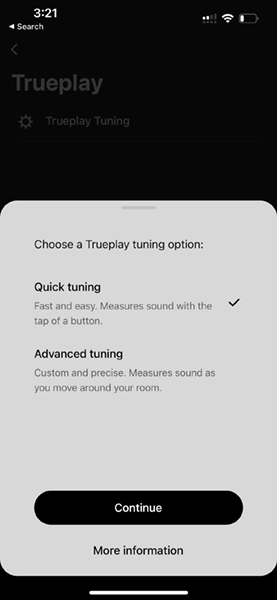 It’s not hard to set up any Sonos speaker—especially if you already have a Sonos system in place. Launch the Sonos app, sign in or register an account, plug it in, look for the blinking light and follow the instructions to connect it to your home W-Fi network. If you’re new to all of this, it’s not hard to do. Sign in to your streaming music apps through the app or send the audio to the speaker directly from other apps. Spotify, Tidal and others already enable that. Since both the Era 300 and 100 support AirPlay 2, it’s an easy tie-in with iOS and MacOS. One of my favourite things to do is use AirPlay on an iPhone to listen to long playlists or live music from YouTube.
It’s not hard to set up any Sonos speaker—especially if you already have a Sonos system in place. Launch the Sonos app, sign in or register an account, plug it in, look for the blinking light and follow the instructions to connect it to your home W-Fi network. If you’re new to all of this, it’s not hard to do. Sign in to your streaming music apps through the app or send the audio to the speaker directly from other apps. Spotify, Tidal and others already enable that. Since both the Era 300 and 100 support AirPlay 2, it’s an easy tie-in with iOS and MacOS. One of my favourite things to do is use AirPlay on an iPhone to listen to long playlists or live music from YouTube.
Compatibility is a two-fold proposition. Streaming services aside, you can listen to any audio you want when pairing either speaker via Bluetooth. Sonos is warming up to Bluetooth after years of avoiding it, and I suspect it will also become a staple of the company’s future speakers.
Both of these speakers have USB-C ports in the back that work with line-in adapters. That way, you can connect other playback devices through a 3.5mm line-in cable for a wired setup. The adapter doesn’t come with either speaker and is sold as a separate accessory.
There’s also Trueplay, Sonos’ tuning system. Since its release, Trueplay required taking an iPhone and waving it around a room for the speaker to gauge its physical dimensions through audible tones reflected back to the phone’s microphone. These speakers can also do that automatically, giving Android users a way to get a similar effect. Personally, I think it’s best to borrow a friend’s iPhone and do it that way as the more precise method.
Where to get spatial audio for Era 300
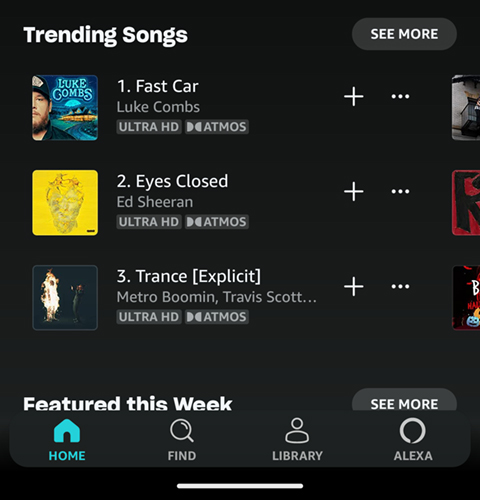 The Era 300 can play spatial audio in Dolby Atmos. I will explain the caveats involved because it is a work in progress. For example, Amazon Music Unlimited offers spatial audio tracks coded in Dolby Atmos, as does Apple Music, so you should have no problem playing and hearing them through the speaker. You just have to make sure the tracks actually indicate it, as in showing “Atmos” or the logo. If you’re not sure whether your iPhone or iPad is doing it with Apple Music, go to Settings > Music > Dolby Atmos. If it’s Automatic, that means it any Atmos music will automatically play with the spatial effect on any headphones or speakers supporting it.
The Era 300 can play spatial audio in Dolby Atmos. I will explain the caveats involved because it is a work in progress. For example, Amazon Music Unlimited offers spatial audio tracks coded in Dolby Atmos, as does Apple Music, so you should have no problem playing and hearing them through the speaker. You just have to make sure the tracks actually indicate it, as in showing “Atmos” or the logo. If you’re not sure whether your iPhone or iPad is doing it with Apple Music, go to Settings > Music > Dolby Atmos. If it’s Automatic, that means it any Atmos music will automatically play with the spatial effect on any headphones or speakers supporting it.
Tidal supports spatial audio and Dolby Atmos, yet neither is compatible with the Era 300. That could certainly change in time, but at the time of this review, you won’t get the effect when playing tracks from that service.
For now, spatial audio is often limited to modern music, so if you’re looking for a classic rock or even 90s R&B tune to play with Atmos on the Era 300, you probably won’t get that chance. Whether or not that changes in time is hard to say.
Where to get hi-res audio
While Sonos places a lot of emphasis on spatial audio for the Era 300, both speakers can play hi-res audio. What’s the difference? Hi-res audio is measured by how much better it plays relative to CD quality, or 16-bit/44.1kHz. The higher those two numbers, the higher the quality of the audio. The best part of this is that it applies far more broadly across genres and eras. You can find a track released in 1973 as easily as you might one released in 2023.
It’s what sets Tidal apart as a unique streaming service because it offers a HiFi tier to stream at CD quality, and HiFi Plus to stream in “Master” quality. The Era 300 and Era 100 can handle these streams, though it may not always play at the highest quality setting. For instance, a Master track may instead play in “HiFi”, which is a step down, yet still better than CD.
Apart from Tidal, Amazon Music has plenty of tracks that fall under “HD” or “Ultra HD”, and you can listen to some of them for free. Try them out and see if you hear a real difference in fidelity. Unfortunately, lossless hi-res tracks on Apple Music won’t play on Sonos—at least not yet.
Note that you won’t get hi-res audio (nor spatial audio, for that matter) via Bluetooth. The Era speakers don’t support hi-res Bluetooth codecs, so you can only hear that kind of quality over Wi-Fi.
Sound quality

It didn’t surprise me Sonos produced good speakers when I heard the Era 300 and 100. The Era 100, in particular, is a noticeable improvement over the Sonos One. While I didn’t get two of them to set up as rear speakers in a surround sound system, I can already tell they will do better in that regard too. I got a taste of that at the press event in New York, and can see the value of upgrading two Sonos Ones with two Era 100s paired with a Sonos Arc or Beam.
On its own, the Era 100 carries a tighter sound that simply resonates more. Not to mention beefier bass that adds a feeling of power under the surface. For those reasons I could get more out of it at the same volume than I could with the One. It’s also because the stereo output in the 100 outclasses the mono One off the bat. If you’re looking for a speaker for a bedroom, kitchen or small living room, it will fit right in.
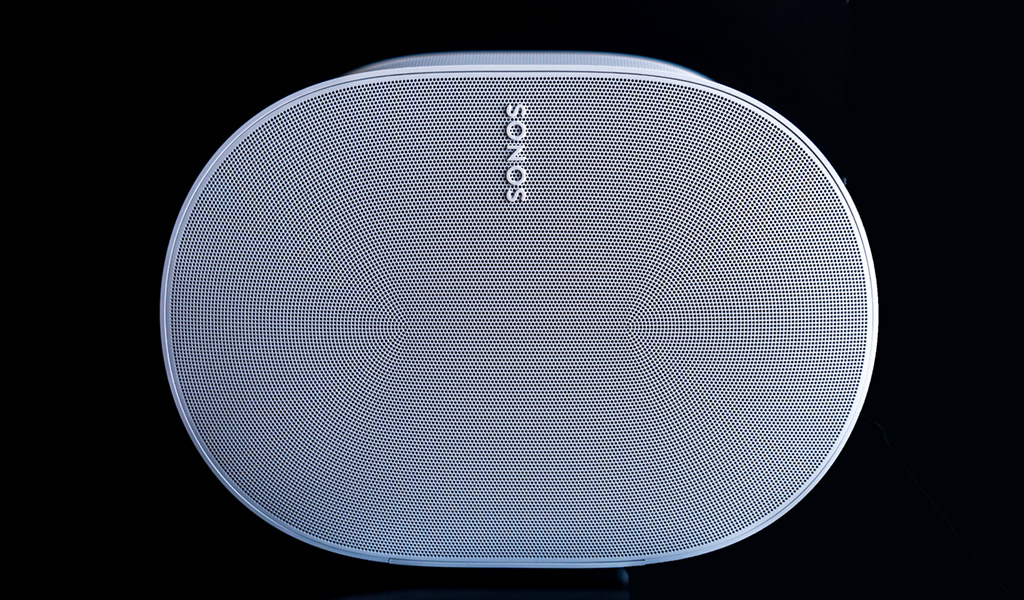
The Era 300 is a stellar speaker, no matter what you play on it. I enjoyed listening to tunes from Spotify, where there’s no spatial or hi-res audio, as much as I did on Tidal and Amazon Music, where I regularly looked for that surround or high-quality output. It can definitely get loud, yet it maintains impressive clarity when it ramps up. Spatial audio tracks really do bring something new to the table because of the grander soundstage that comes with them. I believe live music would sound even better with the effect, but as is, I think you’ll like how enveloping it can feel when giving the volume a boost for studio tracks.
Voice assistance and other details
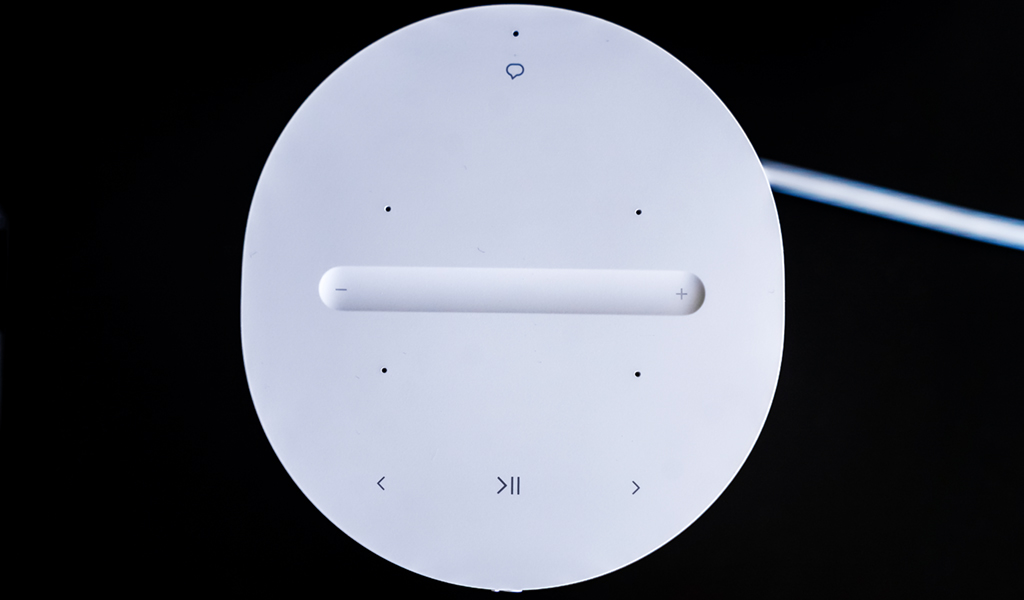
Don’t look for Google Assistant on either of these speakers because it’s nowhere to be found. When that will change remains to be seen. Only Alexa and Sonos Voice Control are currently compatible. Alexa lets you do all the things you could do with other Sonos speakers, including controlling smart home devices. Sonos’ Voice can’t control smart home products, but it can help you tell the speakers what and where to play. Want to move music from one speaker to another? Or ask who the artist is when a good, unknown track plays? It can do both.
The onboard controls also differ on the speakers themselves. An indented sliver acts as a touch-sensitive volume slider. You also get play/pause, back/forward track and voice assistant on/off touch buttons as well. The slider is excellent in its simplicity, though it has no visible way of telling you what the volume is for audio currently playing before you touch it. You’ll also notice the five microphone cutouts at the top for the Era 300 (it’s four for the 100), which are great at capturing voice commands from a fair distance across a room.
Final thoughts
The Era 300 doesn’t outright replace the Sonos Five, a speaker the company will continue to make. They serve different purposes in that the 300 offers spatial audio whereas the Five is more for purists who want superb stereo audio without extras. The Five is not a smart speaker and it has better bass.
The Era 100 is a real improvement over the Sonos One, and ultimately replaces it in Sonos’ lineup. Better design, better sound, more power and stereo architecture make it a worthwhile choice, either when playing solo or as a stereo pair.
Both the Sonos Era 300 and Era 100 are available now in black and white models. If you’re interested in other Sonos products, you can also check them out here.

